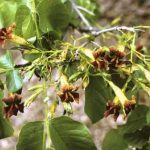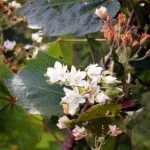TREE LIFE
April 1997
ANNUAL SUBS – NOW DUE
Happily it has not been necessary to increase our subs this year. Please send in your $40 promptly.
MASHONALAND CALENDAR
Tuesday 1st April: Botanic Garden Walk. We will meet Tom in the car park at 4.45 for 5 p.m. This month Tom will start on the family Annonaceae. There will be a guard for the cars.
Sunday 20th April: In February rain washed out what would have been a very interesting trip to the Dyke; as we really don’t want to miss it, this month’s outing is planned for the same place.
Saturday 26th April: Mark’s Botanic Walk is cancelled this month.
Tuesday 6th May: Botanic Garden Walk.
Sunday 18th May: NOTICE OF ANNUAL GENERAL MEETING
Notice is hereby given the 47th Annual General Meeting of the Tree Society of Zimbabwe will be held on Sunday 18th May, 1997 at Mhowani Hills Farm, Teviotdale.
AGENDA
1. Notice convening the meeting.
2. Apologies.
3. Minutes of the 46th AGM.
4. Matters arising.
5. Chairman’s report.
6. Treasurer’s report.
7. Election of committee members.
8. Any other business.
Any proposals/resolutions and nominations for office bearers should be forwarded to P.O. Box 2128, Harare by Monday 12th May if possible, although proposals will be accepted from the floor.
MATEBELELAND CALENDAR
Sunday 6th April: To Nyamandhlovu to a farm run by Sandy and Philip Palmer for an all day outing. Meet at the car park at Girls’ College for a prompt departure at 8.30 a.m.
Sunday 4th May: Trip to Tendele River, S Matopos.
Monday 14th April: Urban trails in Circular Drive area. Meeting at 5-5.15 p.m. These lessons will take place on the second Monday of every month.
Notice is hereby given that the Annual General Meeting of the Matabeleland Branch of the Tree Society will take place at Girl’s College at 7.30 for 8.00 p.m. on the 21st May 1997. Would those attending please come with any suggestions, comments or criticisms which they may have and would like to voice.
AETFAT 1997
What is AETFAT? The letters stand for the Association pour I’Étude Taxomonique de la Flore d’Afrique Tropicale, i.e. the Association for the Study of the Flora of Tropical Africa, generally pronounced in English “Eat fat”!
Every three years, a congress is held, which I believe alternates between a venue in Africa and one outside it. The last congress was held in the Netherlands and this year, the 15th Congress was held in Harare at the University of Zimbabwe.
As it is probably the major event for botanists in Africa, I took time off to attend for the 5 days and indeed it was well worth it. For four days there were lectures, posters and symposia and on the Wednesday a trip in a number of minibuses to the Great Dyke. A number of Tree Society people attended, and three had major roles, namely Bob Drummond, Tom Muller and Jonathan Timberlake.
Perhaps the most interesting thing for me was to see and in some cases to actually meet well known botanists who for years have been merely names in books or authorities attached to plant names. I was surprised by the friendliness and interest shown to an amateur botanist like myself. A large contingent came from Kew and another from South Africa.
I must admit that a number of papers were of a heavy scientific type. I could have done with a briefing on cladistics before I attended, but an equally significant number were reasonably understandable to this botanical layman. With posters and lectures going on simultaneously it was often difficult to decide which to attend.
One paper of interest was a proposal to combine the genus Colophospermum with an Asian genus Hardwickia. This will mean a new name for mopane.
On the Thursday a dinner was arranged in a large tent in the Botanic Gardens. The menu consisted of traditional African plants and animals, with the Latin names helpfully listed.
The aperitif included mopane worms – quite pleasant, even if the heads are rather crunchy! Amongst the many long-term gains of the Congress is the curation by specialists of the plant collections in the National Herbarium.
All in all a most interesting week. This was followed by a trip to the Eastern Highlands where we were lashed by continuous heavy rain throughout and a week later the trip to find Triceratella, written up briefly in last month’s Tree Life.
-Mark Hyde
REPORT ON THE VISIT TO THE MBALABALA BRACHYSTEGIA GLAUCESENS NATURAL RESOURCES RESERVE
On the 2nd of March a convoy of cars set out to Mbalabala from Girl’s College. Actually it was a rather split convoy with some people opting to go on ahead finding their own way. On the way we were treated to several displays of bright red-flowering Aloe zebrina colonies, mostly just before and then after Esigodini with some lovely clumps right next to the road as we were approaching the granite hills near Mbalabala. We had some guti in the hills during the morning but fortunately it was light so we did not get rained out.
Jonathan had done a brief recce and he suggested parking off the main road on a side road leading to a P.T.C. mast behind its fenced enclosure. We didn’t get to the best part of the kopjies of the Reserve but that will have to be done another time. We recorded a fair selection of species – about 84 species of trees, shrubs and climbers.
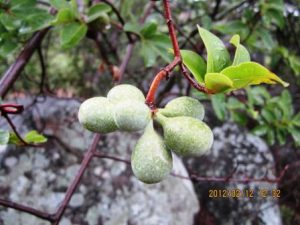
Artabotrys brachypetalus. Photo: Rob Burrett. Source: Flora of Zimbabwe
Of particular interest were the 3 Gardenia, Gardenia resiniflua, Gardenia ternifolia and Gardenia volkensii. Hibiscus mutatus with its white to pale purple flowers was still giving a good show – humbly apologizes for any inconvenience or anxiety caused. Due to this faux pas many Artabotrys brachypetalus and Hexalobus monopetalus were conveniently growing side by side so we could study their similarities and differences.
Unfortunately your Chairman chose this occasion to go bush happy or ‘Get Lost’ for an hour or so, for which most people opted to go home early after their lunch.
Some observations on our outing to Mbalabala – perhaps we need to make our outings more user friendly, especially if we are to attract and not intimidate any new members who want to join our group. We should slow down and explain every plant/tree that we see to everyone who is attending the visit on the particular day. Also we need to carry a copy of the tree book and also Wild’s Dictionary of African & English plant names, to check anything which we think is unusual. A case in point; a number of Ormocarpum plants were seen which we thought looked different from the usual Ormocarpum trichocarpum which we see around Bulawayo. Was it perhaps Ormocarpum kirkii? On checking in Coates Palgrave when I got home they were different only in having much longer leaves than the ones we are used to, but the fruits were typical Ormocarpum trichocarpum, fairly long and almost straight and not curled and hidden in the dry remains of the petals.
However, Clerodendrum wildii was not in doubt. Having seen this species so often when I lived in Harare I remember it well. This may be a new record for this species; certainly the literature that I have does not show it as occurring in the west of Zimbabwe. A specimen will be made and a photograph taken to send to the herbarium in Harare. This sighting was also unusual in that some of the specimens seen were definitely of tree size, in the north, central and east of Zimbabwe it is only recorded as being a shrub.
-Anthon Ellert.
THE TALL, THE FAT, AND THE ANCIENT
Part one: The Tall
A recent copy of the National Geographic Magazine (January 1997) contains an interesting article titled Tree Giants of North America, which includes a brief account of the re-measurement of the world’s tallest-known tree. This is a coast redwood, Sequoia sempervirens, discovered in northern California in 1963 and measured by surveyors as 367,8 feet (112.11m), and reported in the National Geographic of July 1964. The most recent measurement, made in 1995 by climbers with a tape, has established the true height of this tree as 365.5 feet (111.40m).
Now, what about other giant trees that have found their way into the record books? The National Geographic of January 1997 lists maximum heights for the other four of North America’s “big five” as:
Douglas fir, Pseudotsuga menziesii 329 feet (100.28m)
Sitka spruce, Picea sitchensis 315 feet (96.01m)
Giant sequoia, Sequoiadendron giganteum 310 feet (94.49m)
Western Hemlock, Tauga heterophylla 261 feet (79.55m)
Silvics of Forest Trees of the United States, compiled by HA Fowells (1965), indicates a possible record of 385 feet (117.35m) for a Douglas fir (also known as Oregon pine) felled in Washington State. When I was a forestry student a press report on this tree was dismissed by our instructor as “over-enthusiastic journalism”!
Australians are astonishingly reluctant to brag about their big trees, and yet some remarkable records have come out of that country. In 1872 a mountain ash, Eucalyptus regnans felled in Victoria, measured 433 feet (131.98m) to the point where the top had broken off in the fall. This record is not widely accepted by Australians, but those who do accept it point out that the missing top section could have made the whole tree around 500 feet (152m) tall. A much more reliable measurement for a felled Eucalyptus regnans was made in 1918 by no less a personage than the Surveyor-General for the State of Victoria, who recorded the height as 374 feet (114m), but even this has not gained wide acceptance in Australia. There are good records for Eucalyptus regnans of 107m (351 ft), 104m (341 ft), 99m (325 ft) and 98m (322 ft). The present-day champion specimen of Eucalyptus regnans stands in Tasmania, and is 99m (325 ft) tall.
Another eastern Australian eucalypt that occasionally reaches very great heights is manna gum, or ribbon gum, Eucalyptus viminalis, and there is today a standing specimen in Tasmania with a height of 92m (302 ft).
In western Australia the tallest species is karri, Eucalyptus diversicolor, and there is a fairly reliable record of 341 feet (104m) for a specimen felled in 1901. The present-day, tallest-known standing karri is 88m (289 ft).
Around 1910 a Portuguese forester from northern Angola visited the research station where I was based, and related a remarkable figure of 140m (459 ft) for an afara, or limba, Terminalia superba, that he had measured after felling in the rainforest. He must have seen the disbelief on the faces of his listeners, for he repeated the figure and there are still, three of us around who can vouch for what he said!
Zimbabwe is not noted for exceptionally tall trees, but heights of up to 60m (161 ft) are attained in Chirinda Forest by Khaya anthotheca (red mahogany), Lovoa swynnertonii, (brown mahogany), and possibly also Trichilia dregeana (forest Trichilia). There have been exaggerated reports in the past about the height of the Big Tree of Chirinda Forest (Khaya anthotheca) with suggestions of 65m (213 ft) being fairly common. This tree was measured by theodolite in 1939 and found to be 58.8m (193 ft), but by 1986 die-back due to old age had reduced it to 54m (177 ft).
All of Zimbabwe’s tallest trees are eucalypts, and heights of 74m (234 ft) have been recorded for Eucalyptus grandis (flooded gum) at Inodzi near Penhalonga, and Tilbury Estate, Chimanimani. The next best have been 64m (210 ft) for Eucalyptus botryoides (southern mahogany) at Mountain Home, Penhalonga, Eucalyptus microcorys (tallow-wood) at Inodzi, Eucalyptus pilularis (black-butt) at Lemon Kop, Chimanimani and Eucalyptus regnans (mountain ash) at Stapleford, Penhalonga. This last-mentioned tree was not yet 27 years old at the time of measurement, and I expect it to become the tallest in the country in due course; it may already be so for it is now aged nearly 40.
(Next month ‘The Fat’)
-Lyn Mullin.
BOTANICAL GARDEN WALK:
4 March because of rain, it was a pleasure to resume the Botanic Garden walks. After two walks which had been Part 2 of Tom’s discussion of climbing plants.
Two main types of climbers were seen. There were plants which use their petioles or side branches as support. These petioles or branches often project at right angles (or even at a slightly wider angle) from the main stem. Into this category falls the rather rare climber Pseudocalyx saccatus, Embelia schimperi (Myrsinaceae) has petioles which harden into hook-like structures after the leaf lamina has fallen, rather like Combretum mossambicense.
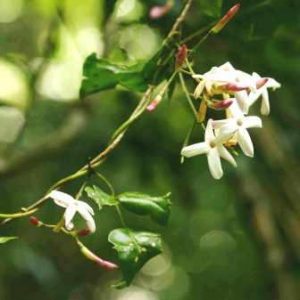
Jasminum fluminense. Photo: Bart Wursten. Source: Flora of Zimbabwe
Two others seen were the Zimbabwe creeper, Podranea brycei, more often seen around Harare as a garden plant. In this case the angled (opposite) leaves provide support. Also seen was a large liana, Jasminum abyssinicum which, like Jasminum fluminense, a fairly frequent climber found in riverine vegetation, has 3-foliate leaves.
The other category was the climbers with tendrils. Two of these are Eastern District species in the Rhamnaceae. Helinus mystacinus is a forest edge species, which possesses tendrils at the edge of the lateral shoots. It has a very similar-looking relative, Helinus integrifolius, which is more widespread in Zimbabwe and occurs in woodland. Gouania longispicata is another plant of the forest margin – this is a much more solid plant than the two species of Helinus, but, again, it has tendrils at the end of the lateral shoots.
Another form of support is provided by adventitious roots. The species which showed this was Urera hypselodendron. This is a climbing and non-stinging member of the nettle family, Urticaceae, again, confined in Zimbabwe to the east.
Artabotrys is a genus well known for its unusual angular hooks. The common Artabotrys brachypetalus is the one most often seen, often scrambling in riverine vegetation. The hooks are initially the stalk which supports the flowers. Once the flowering and fruiting is over the hooks persist. Today, we looked at the rare eastern districts species Artabotrys monteiroae.
Finally, we looked at Rhus chirindensis. Although normally a shrub – fairly common throughout Zimbabwe and certainly not confined to Chirinda as the name might suggest – in this case its thick woody branches were spreading horizontally to form a dense tangle. An extraordinary sight!
Once again, a most stimulating walk and we thank Tom for so regularly giving up his time for the benefit of the society.
-Mark Hyde
The multi-purpose Acacia albida (now Faidherbia albida) an asset to agriculture in Africa.
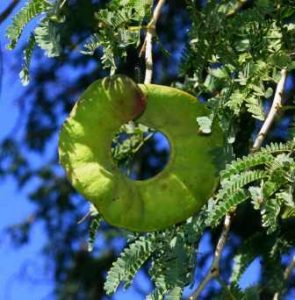
Faidherbia albida. Photo: Bart Wursten. Source: Flora of Zimbabwe
Acacia albida (Faidherbia albida) is one of the largest species of Acacia reaching 30m in height. It is a very diverse species which is widely distributed throughout Africa in a variety of ecologies. Generally it is found at lower altitudes, but it has been recorded at altitudes up to 1800m.
Mature trees have spreading branches and rounded crowns, with rough brown bark. In younger specimens the bark is smoother and a greenish grey colour. Young branches are ash white and distinctively zig¬zag in shape. The thorns are straight, cream-coloured with brown tips and about 2cm long. The grey green leaves are similar to other acacias and are shed during the summer months (summer deciduous).
The flowers are carried on slender creamy-white spikes (4-14cm long) during the winter months. The large reddish-brown, twisted pods (25 x 5cm long) are shed with the leaves between September and October.
Acacia albida is recommended by agroforestry authorities as a multi-purpose tree for a number of agricultural uses throughout the world.
Soil fertility
Acacia albida is most well known for its ability to restore and increase soil fertility. Detailed measurements in West Africa have shown that 20-40 trees-ha provide nutrients equivalent to the prescribed rates of inorganic fertilizer application. Its ability to provide these nutrients occurs in a number of ways:
It is a nitrogen-fixing species which nodulates with strains of Brachyrhizobium that are present in most soils.
The roots penetrate the deeper layers of soil taking up nutrients released by rock weathering which would otherwise be lost by leaching. These nutrients are then deposited on the surface by the leaves which break down rapidly releasing the nutrients in the upper levels of the soil.
Inter-cropping
Acacia albida has for several centuries been used in traditional forms of agriculture. It seems to be tailor-made for summer cropping. The effects discussed above contribute substantially to its suitability in croplands. Competition for light, water and nutrients is minimal because the trees are dormant during the usual cropping season.
Statistical analysis of sorghum, millet and groundnuts grown under Acacia albida indicate not only up to twice the yield, but also far superior quality of crops.
Fodder
Cattle and game are known to browse the leaves and shoots of Acacia albida. The most valuable source of food, however, is the pods which are shed when other sources are scarce. The pods are rich in protein and carbohydrate and can be stored for considerable periods of time before use.
Soil conservation
Acacia albida is a hardy species which can contribute significantly towards limiting water and wind erosion. In addition the soil under Acacia albida trees has better physical conditions including:
Greater cohesion (related to organic carbon %)
Higher water-holding capacity
Better permeability and drainage
Firewood and fuel
The wood is a very good fuel with a high calorific yield. One disadvantage compared to some other species is that it doesn’t coppice easily (i.e. grow again after it is cut). The tree does, however, respond well to pruning!
Timber
The timber is useful and durable and suitable for construction, implement handles and carving.
Bee fodder
The flowers are a valuable source of pollen and nectar at a time of the year when very few species are in flower. They can therefore contribute towards achieving continuity in the supply of bee forage throughout the year.
Fencing
Acacia albida can be useful in fencing as live fences, as a source of fencing standards and for creating an impenetrable barrier by cutting the thorny branches from large trees.
Acacia albida is undoubtedly an asset in any agricultural system. It is an easy tree to propagate either from seed or from root cuttings. It responds well to cultivation although the oft-quoted disadvantage of slow growth rate is evident in many areas.
Without doubt the many advantages of this tree out-weigh the disadvantages. Much work remains to be done in the area of genetic selection of varieties most suitable for cultivation.
From: Farming World November 1996
TREES AND OTHER PLANTS OF DAVID LIVINGSTONE’S ZAMBEZI EXPEDITION 1858-1863
Following his great trans-Africa journey of 1853-1856 David Livingstone was commissioned by the British Government to explore the lower Zambezi, from the delta to the limit of navigation by steam launch, with a view to opening up the interior of Central Africa to “commerce and civilization”. He was appointed “Her Majesty’s Consul at Quilimane at a salary of £500 a year with £170 towards the expense of outfit”.
Other members of the expedition included surgeon-botanist Dr. (later Sir) John Kirk (1832-1922), who was Livingstone’s second-in-command for most of the expedition. Artist Thomas Baines, who left the expedition after being unjustly accused by Livingstone of misappropriating supplies; and Charles Livingstone, David’s younger brother, who was appointed ‘Moral Agent’ to the expedition but came out of it with a question mark against his integrity.
Livingstone was fortunate in having the services of Kirk to collect and identify plants of actual or potential economic importance, but he (Livingstone) was no mean botanist himself. His journals and dispatches contain interesting accounts of trees and other plants he encountered along the route of his expedition on the Zambezi and Shire rivers – modern-day Mozambique, Malawi, and Zambia. Sadly he does not seem to have spent much time on the Zimbabwean side of the Zambezi!
Livingstone generally had to refer to the plants he encountered by their local vernacular names because few of them had been described and named scientifically at that time. But there are two problems here for anyone trying to identify species from his journals:
1) Vernacular names tend to vary from one locality to the next, and
2) Livingstone’s spelling was not at all consistent, whether he was referring to plants, places or people. In spite of these constraints, it is not too difficult to identity practically all the plants mentioned in Livingstone’s Zambezi Journals, and they are listed below.
BAOBAB; 16 September 1858: “….l walked a little way to the South West and found a baobab which Mr. Rae and I, measuring at about three feet from the ground, found to be seventy two feet in circumference; it was hollow and had a good wide high door to it. The space inside was nine feet in diameter and about twenty feet high.”
The baobab is Adansonia digitata – muuyu in Shona and umkhomo in Ndebele – and this particular tree that Livingstone measured at Shiramba on the lower Zambezi was relocated in 1955, when its diameter, at the original height, was found to be 7.17m , an increase of 18cm in 107 years.
BOMA. 4 August 1860: “…Boma, an edible fruit with plenty of oil: very soft wood: by boiling it yields largely.” This journal entry was made on the overland part of the expedition between the ‘Kebrabasa’ (Cabora Bassa) Gorge and the Victoria Falls, four days march from the Falls.
Boma is Ricinodendron rautanenii well known in the Kalahari sand areas of Zimbabwe and Zambia. The Ndebele name is umgoma and the tree bears a superficial resemblance to the baobab. The soft, light wood is often used for carving wooden masks.
BUAZE. 31 May 1859 in Dispatch no.2 to the Earl of Malmesbury: “We propose sending seeds and living plants of the Buaze to India. It becomes a bush and even a tree, yielding a crop annually by being pollarded… The seeds yield oil similar in properties to linseed oil. The fibre is worth between £50 and £60 per ton.”
Journal entry 1 November 1858 – “Buaze in flower. It is like a pea flower and has a very nice scent.”
4 January 1860 – “Dr Kirk found the Buaze to be a Polygala …”
Buaze is, in fact, the violet tree, Securidaca longipedunculata at one time sought after for the strong fibre obtained from its bark.
COFFEE. 10 September 1858, in Dispatch no.11: “…or a coffee tree in blossom: and was informed that a foolish prejudice prevails in the country that he who cultivates coffee cannot enjoy happiness.”
The coffee that Livingstone saw could have been Coffea arabica, brought into the lower Zambezi region by Portuguese colonists or by Arab slavers. It could also have been the wild Coffea racemosa, which has been cultivated for many years in Mozambique and produces a good coffee with its own distinctive flavour. Livingstone’s Journal entry for 3 October 1859 notes “Wild coffee found yesterday …”
COLORYNA. 24 January 1861 “Coloryna, a Rhamnaceaous tree found by Dr. K. Some kinds cause quick fermentation.” This journal entry was written at the coast and could have been a reference to Colubrina asiatica, a scrambling shrub of coastal Mozambique, but the note on “quick fermentation” is obscure. Other genera and species of the family Rhamnaceae that Livingstone might have been referring to are Ziziphus abyssinica, Ziziphus mucronata and Berchemia discolor. All are shown in Coates Palgrave’s Trees of Southern Africa as occurring down to the Zambezi delta, and all have edible fruits that could be used in the fermentation of alcoholic beverages. Ziziphus abyssinica is known in Shona as musawu, while Ziziphus mucronata is muchecheni in Shona and umphafa in Ndebele. Berchemia discolor is the well-known munyii (Shona) or umnyiyi (Ndebele) of the Zambezi Valley and south eastern lowveld. If ‘Coloryna’ refers to a Ziziphus, one would expect it to be distinct from macaa or jujube, which Livingstone noted around the lower Zambezi during this same period in other writings.
CONGO BEANS. 16 June 1863: “Voandzeia or Congo beans still growing, but not a soul to be seen.” This was written during the exploration of the Shire River, which drains Lake Malawi into the Zambezi and then to the sea.
The Congo bean is Voandzeia subterranea, the well-known nyimo (Shona) or indlubu (Ndebele), a native of West Africa, which has been widely cultivated since ancient times.
COTTON. Dispatch no.111 10 September 1858: “The cotton grown in this country is of two kinds, that called Tonje manja, as the added adjective implies, is an imported variety and in the delta has a very fine long staple. The other, Tonje caja, is native and has a very short pile which clings to the seed and feels more like wool in the hand than cotton. Native cloth of this is very highly valued. Patches of cotton a few yards square are seen in most native gardens.”
The dispatch was written from Tete, but there are numerous references to cotton in Livingstone’s Journals. The spelling of the name for imported cotton, Tonje manja, is one of numerous inconsistencies in Livingstone’s writings; usually, and probably correctly, he spelt it as Tonje manga. Gossypium hirsutum, which originated in the Americas, was probably imported by the Portuguese or Arab slavers. Tonje caja, the indigenous Gossypium herbaceum var. africanum has been cultivated from ancient times, but is now largely replaced by Gossypium hirsutum because of the latter’s longer lint.
COWITCH. 2 June 1860: “People in this hilly region collect quantities of the cow-itch pods and burn off the prickles before extracting the beans as food. It is extensively used as an article of food, though always quite wild. One kind is cut into thin slices before being boiled.”
4 October 1861. “Cow itch very annoying.” Livingstone observed the use of cow itch pods as food in both the Zambezi and the Shire valleys, and there is no doubt at all that he was referring to what we know today as buffalo bean, Mucuna coriacea or Mucuna pruriens. There are about 35 species of Mucuna in the tropics and subtropics, and one variety of Mucuna pruriens is the Florida velvet bean, a useful fodder. The Shone names for buffalo bean are hohozhwa hurukuru, or uriri.
FIG. 10. 28 July 1860: “breakfast under a large fig tree on plain.” This was written about seven days before reaching Victoria Falls from Tete and Cabora Bassa, and the fig could have been any one of 8-9 species of Ficus that occur in the Zambezi Valley as large trees. Ficus sur, Ficus natalensis, Ficus sansibarica and Ficus sycomorus would have been among the figs Livingstone encountered most commonly on his overland trip.
These anecdotes are extracted from an interesting document researched and written by Lyn Mullin.
To be continued.
ANDY MACNAUGHTAN CHAIRMAN


